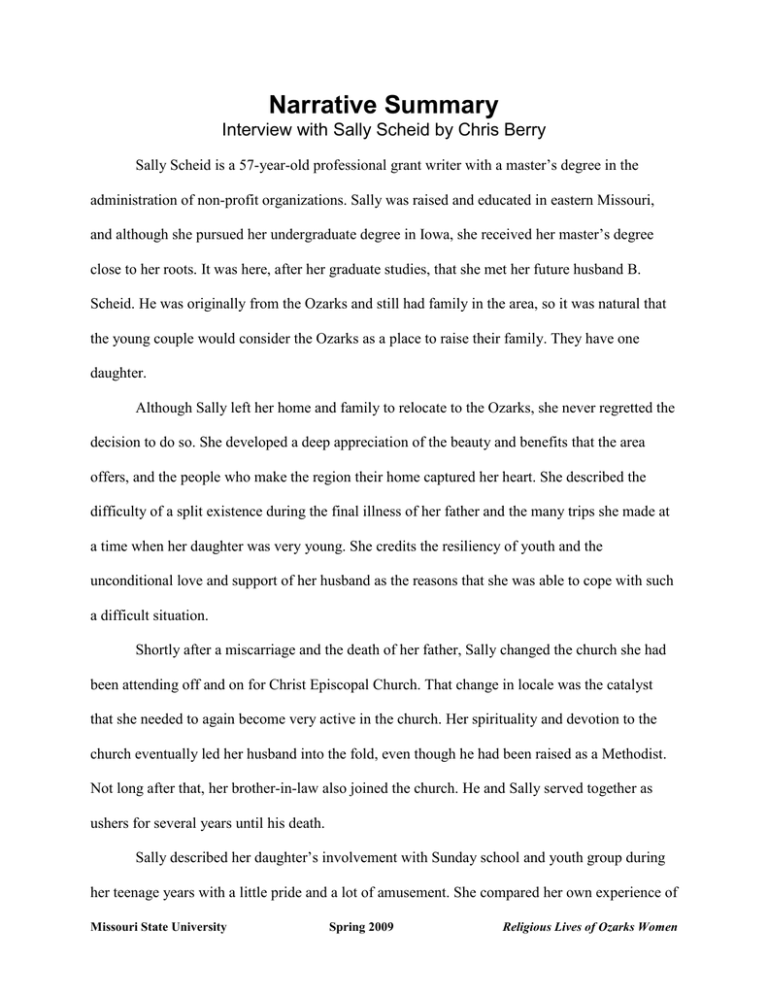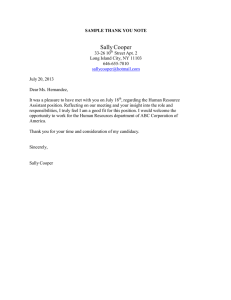Narrative Summary Interview with Sally Scheid by Chris Berry
advertisement

Narrative Summary Interview with Sally Scheid by Chris Berry Sally Scheid is a 57-year-old professional grant writer with a master’s degree in the administration of non-profit organizations. Sally was raised and educated in eastern Missouri, and although she pursued her undergraduate degree in Iowa, she received her master’s degree close to her roots. It was here, after her graduate studies, that she met her future husband B. Scheid. He was originally from the Ozarks and still had family in the area, so it was natural that the young couple would consider the Ozarks as a place to raise their family. They have one daughter. Although Sally left her home and family to relocate to the Ozarks, she never regretted the decision to do so. She developed a deep appreciation of the beauty and benefits that the area offers, and the people who make the region their home captured her heart. She described the difficulty of a split existence during the final illness of her father and the many trips she made at a time when her daughter was very young. She credits the resiliency of youth and the unconditional love and support of her husband as the reasons that she was able to cope with such a difficult situation. Shortly after a miscarriage and the death of her father, Sally changed the church she had been attending off and on for Christ Episcopal Church. That change in locale was the catalyst that she needed to again become very active in the church. Her spirituality and devotion to the church eventually led her husband into the fold, even though he had been raised as a Methodist. Not long after that, her brother-in-law also joined the church. He and Sally served together as ushers for several years until his death. Sally described her daughter’s involvement with Sunday school and youth group during her teenage years with a little pride and a lot of amusement. She compared her own experience of Missouri State University Spring 2009 Religious Lives of Ozarks Women 2 church, one in which women had no role in liturgy or leadership, to the experience her daughter had. By the time that she was ready to become involved in the church, roles for women in the liturgy and in the full life of the church were already established. Roles that Sally had been denied were available to her daughter. She described her feeling of wanting more of a ministry for herself, but she wanted a role without the threat of overshadowing her daughter. The two roles that she settled upon after prayer and reflection were those of lay reader and Eucharistic minister. As a lay reader, she participated in the liturgy by reading the appointed lesson from scripture to the congregation, a role that women did not partake of while she was growing up in the church. As a Eucharistic minister Sally played an even more central role—administering the sacramental cup of wine to the communicants. This mother-daughter combination represents two generations of women serving the same church in very public and visible roles. In part two of the interview, Sally spoke of the expansion of her confidence and faith into new frontiers of spiritual growth and action in her community. Her literacy mentorship of grade school children, active involvement in church studies, and spiritual inspiration from sources outside of the church help her effectively model the expanded roles for twenty-first century women as they continue to redefine femininity, spirituality, and gendered expression both in and out of religious contexts. Missouri State University Spring 2009 Religious Lives of Ozarks Women




